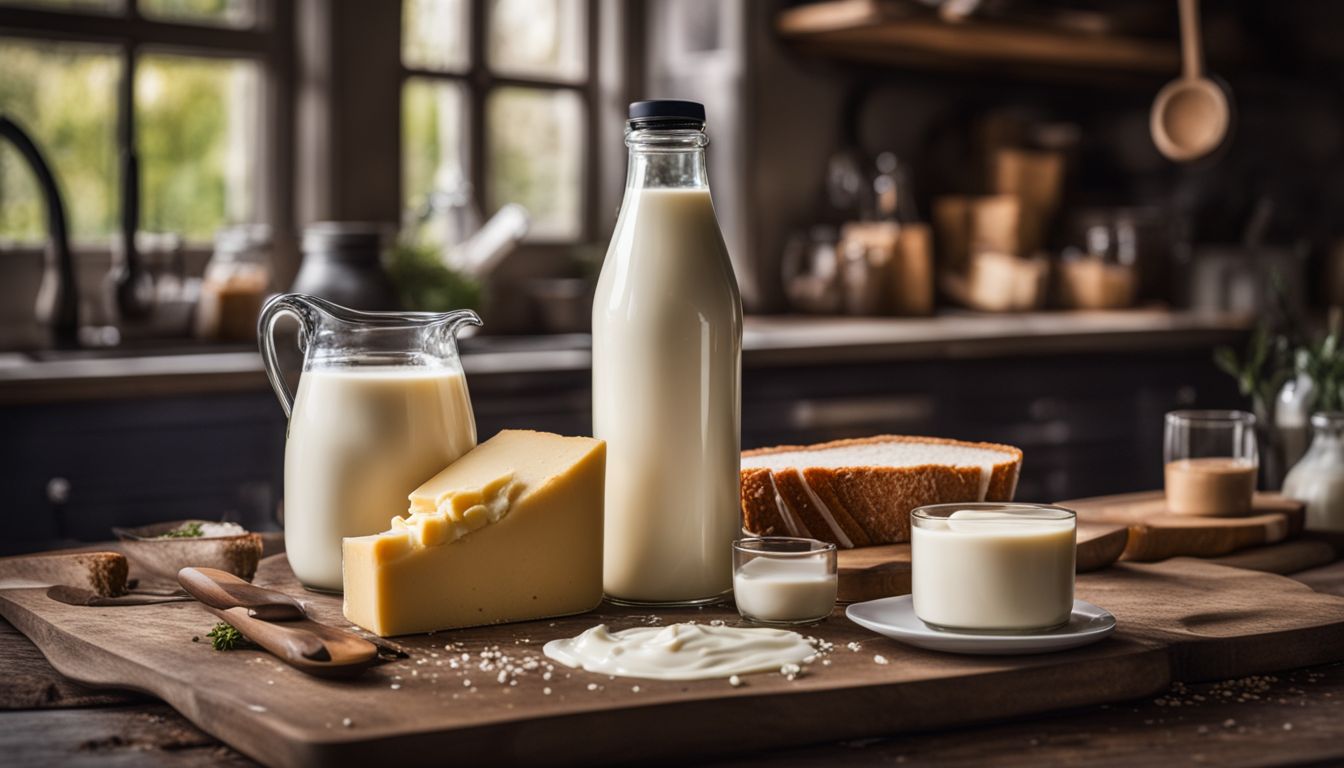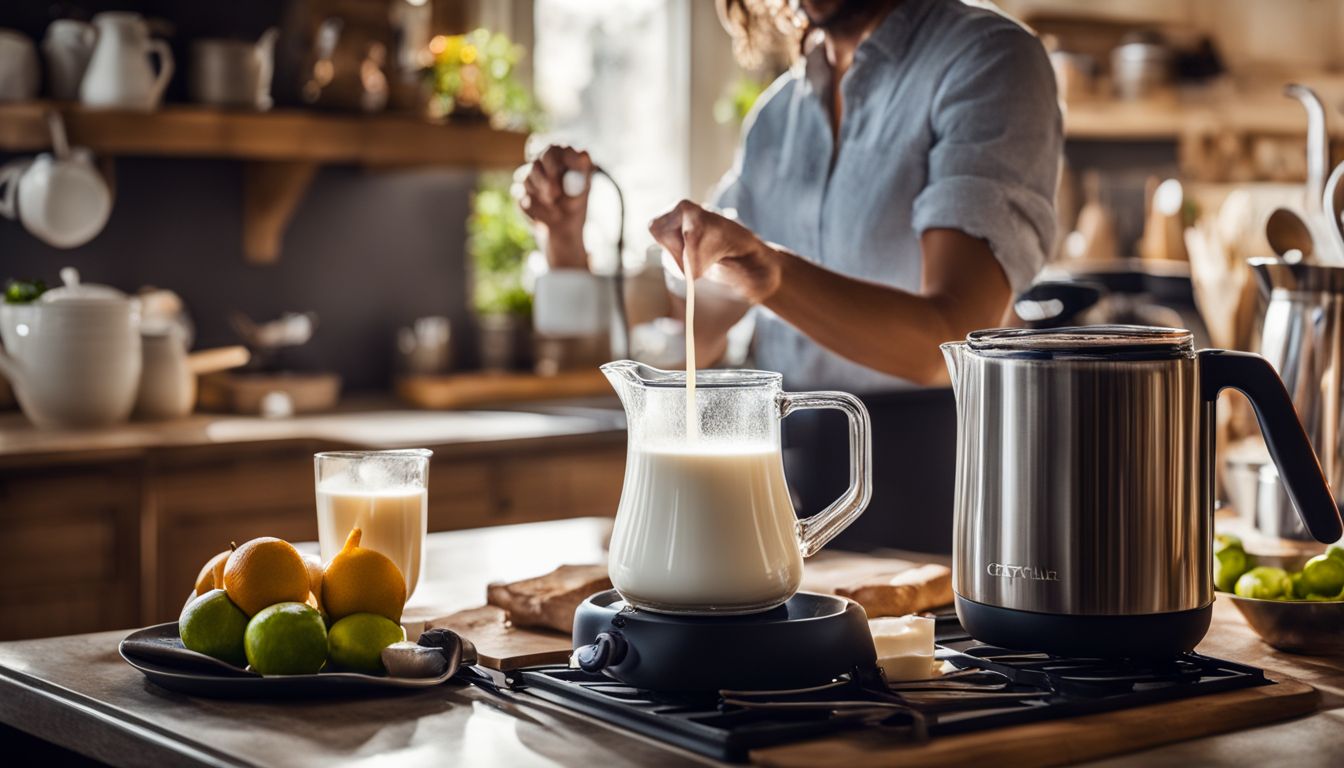“This post contains affiliate links. As an Amazon Associate, I earn from qualifying purchases”
Are you gearing up to create a mouth-watering dessert when suddenly you realize the heavy cream is missing from your fridge? You’re not alone. As someone who’s spent countless hours in various kitchens creating culinary masterpieces, I’ve run into this very scenario more times than I’d like to admit.
My culinary adventures across the globe have armed me with an arsenal of kitchen hacks, especially for those moments when key ingredients are amiss. One of my favorite revelations has been discovering the wonders of milk—not just as a breakfast staple but also as a miraculous substitute for heavy cream.
Shockingly, despite heavy cream containing 36% to 40% fat and whole milk only having about 3.5%, there’s no need to panic or dash to the store when all you have is milk. By adding butter to whole milk, we can achieve that luxurious texture and fat content so often desired in recipes calling for heavy cream.
Stick around; it’s easier than it sounds!
Key Takeaways
- Milk can become a heavy cream substitute by mixing it with butter. This mix gives foods a rich taste.
- Heavy cream is very fatty, making foods creamy and smooth. But milk with added fat like butter or oil can do the job too.
- You can use just milk instead of heavy cream in some recipes, especially when cooking soups or sauces.
- If you need milk to act more like heavy cream in baking, adding butter helps match the needed fat content.
- For those watching their diet, skim milk mixed with butter also works as a lighter option for heavy cream.
What is Heavy Cream?

Heavy cream is the thick, rich part of milk that rises to the top. It makes dishes creamy and delicious.
Its role in recipes
Heavy cream steps in to make dishes rich and creamy. In soups and sauces, it’s a star because it doesn’t curdle when boiled. Think about the smoothness of ice cream or the velvety texture in cheesecakes – that’s heavy cream doing its magic.
It adds depth to mashed potatoes and turns a simple bowl of soup into something you can’t stop eating.
Now, not everyone keeps heavy cream on hand. That’s where milk comes in as a handy substitute. Let me walk you through how to swap heavy cream with milk for those lighter versions of your favorites without losing the essence of what makes them special.
High fat content
Heavy cream is really rich because it’s full of fat, way more than what you find in milk or light cream. Think about it—36% to 40% of heavy cream is just fat! That’s why when we whip it up, it gets all thick and fluffy, which is perfect for making desserts creamy or adding a lush touch to sauces.
Now, here’s a fun fact: this high-fat goodness isn’t just about taste; it also packs vitamins and minerals. Yes, even though we’re talking lots of calories here, there are some nutritional perks too.
Seeing as heavy cream has so much more fat than many other dairy products like half-and-half or whole milk, not even whipping cream matches up. This makes me think about how we can still create that rich texture without always reaching for the heavy cream carton..
Let’s dive into how milk might step in as a substitute.
Rich and creamy texture
Heavy cream shines because of its rich and creamy texture. It makes desserts and sauces smooth, inviting us into a world where every bite feels luxurious. This texture comes from its high fat content—think about how thick and silky whipped cream is right off the spoon.
Now, if I’m out of heavy cream, I don’t panic. Mixing milk with something like butter or cornstarch can mimic that indulgent feel. For instance, adding unsalted butter to whole-milk gives it a boost in richness, getting close to what heavy cream offers.
It’s all about finding the right balance to achieve that desired velvety touch in recipes without losing the lushness we love so much.
Milk as a Substitute for Heavy Cream

Sometimes, I run out of heavy cream when I’m in the middle of cooking. That’s when milk steps in as a handy substitute, offering a lighter touch to my favorite dishes.
How to replace heavy cream with milk
I know you’re eyeing that recipe and wondering how to ditch the heavy cream for something lighter. Well, I’ve got a trick for you. Grab some whole milk and butter from your fridge.
Why? Because mixing these two can magically turn them into a heavy cream alternative. Here’s what you do: melt 1/4 cup of butter and whisk it with 3/4 cup of milk. Just like that, you’ve got yourself one cup of a creamy substitute ready to dive into sauces or pasta dishes.
Let’s say you’re out of butter too – no problem! Milk on its own can still stand in for heavy cream, especially in cooking where the rich texture is not the star of the show. For those moments, just use plain milk in place of heavy cream without any adjustments.
It may be lighter, but your sauces will thank you for the smooth finish they’ll get with this simple swap. Trust me; your pasta won’t know the difference.
Tips for successful substitutions
To make a good switch from heavy cream to milk, adding fat is key. You can stir melted unsalted butter into whole milk for a thick and creamy result. This mix works wonders in most recipes calling for heavy cream.
If you’re going vegan or dairy-free, don’t worry! Combine your favorite alt milk with olive oil. Yes, olive oil! It gives a rich flavor that’s pretty close to the real thing.
For something lighter, try evaporated milk instead of regular milk. It’s less fatty but still brings a creamy touch to your dishes. Oh, and when cooking or baking with these swaps? Keep an eye on the texture and taste as you go.
A little tweak here and there might be needed to get it just right.
When to use milk as a substitute
I find myself reaching for milk instead of heavy cream in many situations, especially when I’m all out and the store is too far away. It’s a great trick for sauces or soups where you crave that creamy touch but don’t need the full richness heavy cream brings to the table.
Think about your morning coffee or a light pasta sauce – here, milk does the job pretty well.
Baking is another story. For cakes and pastries that ask for heavy cream, I mix some butter into my milk to mimic that fat content and texture we love about cream. This way, even with lower fat options like skim milk or plant-based milks such as almond milk and oat milk, I still get delightful results without having to change my plans last minute.
Conclusion
Yes, you can use milk as a substitute for heavy cream in recipes. By adding butter to it, you boost the fat content, making your dishes rich and tasty. Remember, skim milk works too if you’re watching calories.
For cooking and baking that need a creamy touch without the heaviness of cream, try this simple trick. It’s a clever way to keep enjoying your favorite meals while tweaking the richness according to your preference.
FAQs
1. Can milk replace heavy cream in recipes?
Yes, you can use milk instead of heavy cream. If you mix a little bit of milk with some butter or cooking oil, it works well for many dishes.
2. What if I need a non-dairy option?
For those avoiding dairy, try coconut milk, soy milk, or cashew milk as great substitutes. They add a creamy texture to your recipes without using cow’s milk.
3. Is there something else I can use for thickening besides heavy cream?
Sure! Greek yogurt, sour cream, and even cottage cheese can thicken your meals. Mix them with plain yogurt or low-fat milk to get the right consistency.
4. Can I make desserts without heavy cream?
Definitely! Use frozen yogurt or a whipped topping as an easy swap in desserts. For sweet creams or frostings, silken tofu blends smoothly when mixed with confectioners’ sugar.
5. Are these alternatives healthier than heavy whipping cream?
Often yes since most substitutes like coconut cream and crème fraîche have less fat compared to heavy whipping cream but remember they change the flavor too!
6. Will changing from heavy cream to another option affect my recipe’s taste?
Switching ingredients might tweak the taste slightly – for instance, coconut products bring a tropical hint while Greek yogurt adds tanginess… But experimenting is part of the fun in cooking!